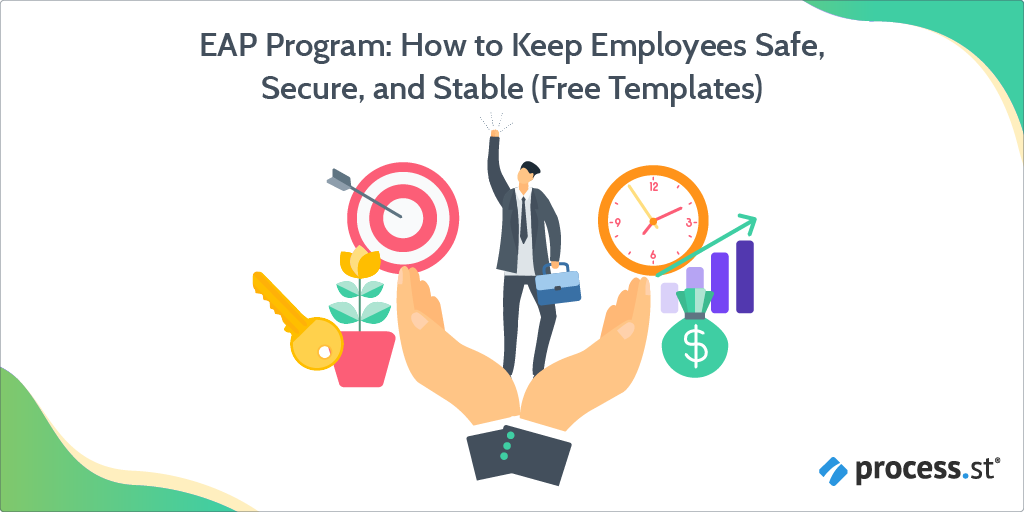
There are countless ways employees can be thrown off their A-game – from anxiety to altercations at work, pandemics to problems at home.
But how can employers improve the mental, emotional, and physical well-being of their staff?
By implementing an employee assistance program (EAP).
According to the International Employee Assistance Professionals Association, 97% of U.S. companies with over 5,000 employees already have an EAP program in place. Small and midsize businesses realize the huge benefits of EAP programs too, as 75% of businesses with 250 – 1,000 employees also make use of EAP programs.
Hasn’t your business instigated an EAP program already?
If not, it’s about time you thought about it.
By reading this post, you’ll understand what exactly an EAP program is, the history of it, why it’s beneficial for employers and employees alike, and even gain access to EAP templates created by Process Street. Make your way through the following sections to get clued-up:
- What is an employee assistance program (EAP)?
- The history of the employee assistance program
- Employee assistance program benefits
- Process Street’s EAP program templates
- Use Process Street to ensure your workforce are safe, secure, and stable
If you’re in a rush, here are the links to the free EAP templates:
- Critical Incident Stress Management Checklist
- Achieving Work-Life Balance Checklist
- Work Anxiety Resolution Checklist
- Daily Schedule Template
- Office Conflict Resolution Checklist
- Lisa A. Romano: Overcoming Negative Self-Talk
- Mental Health Risk Assessment Checklist
- SMART Goal Setting Checklist
- Records Disposal Checklist
There’s a lot at stake, so let’s get started with the rest of the post. ⏳
What is an employee assistance program (EAP)?

As Ben Mulholland says in his post Employee Assistance Program: How To Treat Your Team With Humanity:
“An employee assistance program (EAP) is a service that an employer, union, or outside body provides to help employees deal with personal problems. While the problems can be caused by anything, the focus is on things that affect work performance – this can even extend to the employee’s family too.” – Ben Mulholland, Employee Assistance Program: How To Treat Your Team With Humanity
Usually, these employee issues include:
- Stress
- Burnout
- Work anxiety
- Poor work-life balance
- Depression
- Bereavement
- Substance abuse
- Critical incidents (such as an assault or accident)
To ensure that employees are properly looked after, an EAP program is made up of a myriad of processes.
These processes are:
- Confidential assessments
- Immediate measures (e.g. critical incident stress management)
- Short-term counseling
- Long-term counseling
- Referrals
- Follow-ups
Now, who initiates these processes will differ by organization.
A small enterprise may choose to outsource their EAP program to an outside body, where employees will be fully taken care of by EAP professionals.
Meanwhile, a larger enterprise may have the resources to manage their EAP program in-house, either by directly employing EAP counselors and professionals or by training their HR team to deliver EAP-related processes properly.
Whether outsourced or used in-house, EAP programs have been implemented and delivered by progressive organizations for decades (nearly a whole century, in fact).
But how did the EAP come about? And how have EAPs changed to suit contemporary needs?
The history of the employee assistance program

In 1930s America, country-wide efforts were established to help employees resolve themselves of alcoholism.
Why?
Because the drinking culture at the time was pervasive, meaning alcohol would be drunk extensively – sometimes even while on the job.
These alcohol assistance programs were essentially a proto form of what’s now recognized as an employee assistance program. But due to the social stigma attached to alcoholism and the insufficient training for supervisors, the initial programs weren’t successful.
It wasn’t until the 1960s that progress was made, thanks to companies like The Eastman Kodak Company and Kemper.
The alcohol assistance program was expanded upon to address alcohol rehabilitation, while also including the needs of the employee’s family members. Essentially, this meant that the program broadened; other mental, emotional, marital, and financial needs were taken into consideration. This is when the employee assistance program really took form.
The EAP then became nationally and internationally recognized not only as an incredibly useful program, but something that was truly necessary.
The contemporary employee assistance program
After the early 2000s, EAPs once again broadened in scope.
Due to critical incidents such as natural disasters and terrorism, processes such as incident debriefing were included in EAP programs. The checklist template embedded below is an example of such a process.
Additionally, with the rise of occupational stress and work anxiety, this meant the inclusion of processes that would tackle those workplace issues.
All in all, EAP programs have stood the test of time by adapting to what the workforce needs.
Contemporary EAP programs provide benefits not only to employees who are suffering from substance abuse, but also those having problems with anxiety, depression, burnout, or even the fallout of a major critical incident.
Employee assistance program benefits

I’ve primarily spoken about how EAP programs are beneficial for employees so far. While that’s certainly true, the benefits are two-fold.
Ergo: With an EAP program in place, both employer and employee win.
Let’s delve into the positives both parties gain, starting with the employee.
- Immediate assistance.
- Confidential support.
- Improved workplace culture.
Generally speaking, employees have access to EAP professionals 24 hours a day. This means they can immediately speak to somebody about what’s troubling them, get a referral if advanced psychological attention is needed, or get any other appropriate processes underway.
No matter the struggle, everything the employee discusses with the professional(s) they’re working with will remain confidential. This is an aspect that will encourage employees to talk about the issues they’re dealing with, and subsequently receive the help they need and deserve.
With a permanent EAP program in place, employees will know that if they ever face an issue or problem that impacts their ability to work, they’ll be able to quickly receive support. This leads to increased psychological security in addition to a happier, more open workplace. All in all, an improved workplace culture!
In terms of the employer, these are the rewards they’ll reap:
- Increased productivity.
- Decreased absenteeism.
- Conserved finances.
When employees can’t focus properly due to their personal problems and circumstances, the amount they get done each day will naturally dip. Let’s say an employee is going through the process of bereavement, but doesn’t get help from their employer – the productivity dip could last for months on end, causing additional stress or worry. But by helping the employee to manage their bereavement with an EAP program, they can get back to doing stellar work when they’ve recovered.
When an employee is struggling with an issue, they’re more likely to take time off work. And while taking time for holidays and to recuperate is important for well-being, you don’t want the employee’s problems to result in absenteeism. Thankfully, EAPs reduce sick leave usage by 33% and lost time by 40%.
Having EAP programs in place saves businesses money. From increased employee retention to reduced overall employer healthcare costs, an EAP program isn’t costly but rather cost-effective.
An impressive list of benefits, right?
The good news is that these six benefits only scratch the surface of all the positives that EAP programs bring.
If you’re now raring to implement an EAP program for your business, hold up; we’ve got several ready-made, ready-to-go checklist templates for you to use.
Process Street’s EAP program templates

EAP programs are, essentially, a collection of processes. So what better way to ensure you undertake the processes properly and reduce human error than by following checklists? (Spoiler: There isn’t a better way.)
Below, you’ll find a collection of EAP-related processes you can run in-house, pass onto your outsourced EAP team, or some that your employees can run themselves.
First, I’ll go over three core processes that all EAP programs need to make use of. Then, you’ll look at several other checklists that’ll help with team altercations, mental health, and keeping a steady daily routine.
Critical incident stress management checklist
Life is tough. And then there are times when the tough really gets going.
If an employee experiences a life-changing event – a critical incident – the best way to aid their recovery is by managing the stress they experience immediately.
Why?
Because without critical incident stress management, the employee could spiral downwards.
This Critical Incident Stress Management Checklist begins with the user defusing the situation (ensuring that the employee is supported within 12 hours of the incident happening, and that all their basic needs are met).
Then, the debriefing stage takes place, where the user has a more in-depth conversation with the employee about the incident and helps them get the right support and/or services.
After that, there’s the follow-up stage. The user follows-up with the employee to see if everything’s OK, and then takes any appropriate further action.
It’s an easy-to-use checklist that has a monumental impact.
Click here to get the Critical Incident Stress Management Checklist.
Achieving work-life balance checklist
Although working remotely, working from home, and the plethora of portable tech available to us is undeniably advantageous, there is a downside: Replying to emails or working on a project into the night has become the norm.
In fact, 26% of work is done outside of normal working hours – which isn’t healthy.
That’s why this Achieving Work-Life Balance Checklist was created.
EAP professionals, HR staff, or line managers should hand this checklist template to employees if they’ve expressed difficulty in stopping work at an appropriate time.
The checklists itself starts with the employee specifying which day of the week it is and where they’re working from. The tasks then dynamically adapt to the user’s needs, thanks to conditional logic.
After confirming those basic details, the employee then begins the process of wrapping up work, moving to a space they can truly relax in, and doing the activities they enjoy.
An approval task is at the very end of the checklist. Essentially, this means the higher-up who provided the employee with the checklist template can review what the employee has done, ensuring that they’re making steps toward a healthy work-life balance!
Click here to get the Achieving Work-Life Balance Checklist.
Work anxiety resolution checklist
Perhaps unsurprisingly, studies have shown that 93% of Americans experience stress at work.
Stress can easily transform into work anxiety – a type of anxiety that’s fueled by thoughts or actions related to work.
Luckily, for EAP professionals, HR staff, and line managers, they can give this checklist template to employees who are struggling with anxiety at work. Additionally, employees who want to tackle work anxiety off their own back can add this checklist template to their dashboard and run through it themselves!
The checklist starts with the employee addressing their work anxiety by stating why they’re anxious, and confirming the anxiety symptoms they’re feeling and/or displaying.
Afterward, the checklist guides the employee through several anxiety-quashing tasks suggested by the likes of The Anxiety and Depression Association of America (ADAA), Mind, and Verywell Mind.
This particular checklist should be launched by employees whenever work anxiety rears its ugly head and as soon as possible so it can be diminished quickly.
Click here to get the Work Anxiety Resolution Checklist.
More useful templates for EAP programs
Whether employees are coming back after a critical incident or if extra measures are needed to sustain a good work-life balance, there’s this Daily Schedule Template.
Click here to get the Daily Schedule Template.
The office isn’t always a harmonious place.
If a conflict arises between employees, this checklist can be used as part of an EAP program to help resolve those issues – quickly.
Click here to get the Office Conflict Resolution Checklist.
Conflict doesn’t always involve two or more people.
Sometimes, internal conflict can stop an employee from doing their best work.
When employees are struggling with their negative internal critic – which is more pronounced in sufferers of anxiety and depression – hand this checklist to them. It’s based on life coach Lisa A. Romano‘s successful approach to overcoming negative self-talk.
Click here to get the checklist Lisa A. Romano: Overcoming Negative Self-Talk.
Let’s say you – or somebody else – need to perform a mental health risk assessment on an employee.
This checklist will help the user reduce human error, increase accountability, and ensure that the risk assessment is done properly and professionally.
Click here to get the Mental Health Risk Assessment Checklist.
To help employees get back on track with their work after a difficult period, provide them with this incredibly efficient, wonderfully effective SMART goal process.
Click here to get the SMART Goal Setting Checklist.
By having an EAP program in place, a collection of records and documents will naturally build up.
Seeing as these records and documents contain personal, sensitive information, they need to be disposed of regularly.
Use this Records Disposal Checklist to dispose of those documents the right way.
Click here to get the Records Disposal Checklist.
If you like the look of these templates but wanted to change them to suit your EAP program’s specific requirements, have no fear. It’s easy to edit templates to your liking.
Alternatively, you can create your own templates from scratch!
Find out how in the next section… ⬇️
Use Process Street to ensure your workforce are safe, secure, and stable
Process Street is superpowered checklists.
If you document workflows, business processes, and integral procedures as checklist templates, you and others can launch an infinite amount of checklists from those templates.
This means when recurring tasks are tackled, they’re always completed thoroughly.
For a quick visual introduction to our nifty BPM software, check out the video below.
What makes Process Street checklists supercharged, exactly, is our workflow automation features.
These include (but aren’t limited to):
- Stop tasks. ✋
- Conditional logic.
- Dynamic due dates. ⏱
- Task permissions.
- Task assignments.
- Role assignments.
- Webhooks.
- Embed widget.
- Approvals. ✅
As an example, you can use task permissions to ensure the private, sensitive information concerning employees can only be seen by the right eyes!
To learn more about some of these features, watch the following webinar.
Additionally, making your own EAP templates is a breeze with Process Street.
Just sign up to our business software for free, then get building checklist templates in the template editor. Once you’ve documented your essential processes, you or others can use them for everything EAP-related!
Simple.
Additional resources for bolstering your EAP program
I’ve provided you with a ton of templates to add to your dashboard and use.
But the free resources don’t end there.
Next up is a list of blog posts concerning topics related to HR, employee assistance, and employee happiness.
Read through. Take the information in. Ensure your business does all it can to create a happy, thriving workplace.
- Employee Assistance Program: How To Treat Your Team With Humanity
- Work Anxiety: How To Create a Happy Workplace That Fosters Productivity
- 60+ Essential HR Processes for All Human Resource Teams (Free!)
- 12 HR Management Tips to Run an Effective Business (and Prevent Total Chaos)
- What is Workplace Diversity? Improving Diversity in the Workplace (8 Free Templates)
- Workplace Culture: What It Is and How to Make Yours Better (With Examples)
- Key Takeaways from 5 Excellent Company Culture Examples
- Burnout: How I Beat It, and How You Can Too
- Employee Engagement: How to Get a Happy, Productive Team
- The 11 Efficiency Killers in Your Workplace That You Should Know About
- How To Boost Efficiency with Advanced Process Street Features
- How to Use Checklists in the Workplace for Maximum Success
There you have it.
With the information provided in this post, the free EAP templates, and the list of valuable reading material, your business can implement and sustain a stellar EAP program.
Does your business have an EAP program in place? Are there any tips and tricks for creating a successful EAP program that you’d like to share with the Process Street community? Write your suggestions below!







 Workflows
Workflows Projects
Projects Data Sets
Data Sets Forms
Forms Pages
Pages Automations
Automations Analytics
Analytics Apps
Apps Integrations
Integrations
 Property management
Property management
 Human resources
Human resources
 Customer management
Customer management
 Information technology
Information technology



Thom James Carter
Thom is one of Process Street’s content writers. He’s also contributed tech-related writing to The New Statesman, Insider, Atlassian, G2, The Content Marketing Institute, and more. Follow him on Twitter @thomjamescarter.